Personal and Professional Development: Self-Assessment Report
VerifiedAdded on 2023/01/04
|26
|4316
|3
Report
AI Summary
This report provides a comprehensive analysis of personal and professional development, focusing on self-management and leadership skills. It explores the impact of change on employees, differentiating between positive and negative responses and their influence on organizational workflows. The report offers advice to leaders during the implementation of change, emphasizing self-development plans, interpersonal relationship management, and effective team-working practices based on Belbin’s Team Roles Model. It delves into the implications of leadership skills, adaptability within the business environment, and motivational theories such as Maslow’s Hierarchy of Needs and McClelland’s Need Theory. Additionally, the report includes a skills audit using the STARR formula, an overview of leadership theories, and a reflection on professional and personal achievements. The content is enriched with frameworks and models to provide a structured understanding of the subject, aiming to guide individuals in their journey towards professional and personal success. The report is designed to help students and professionals alike enhance their leadership and self-management capabilities.
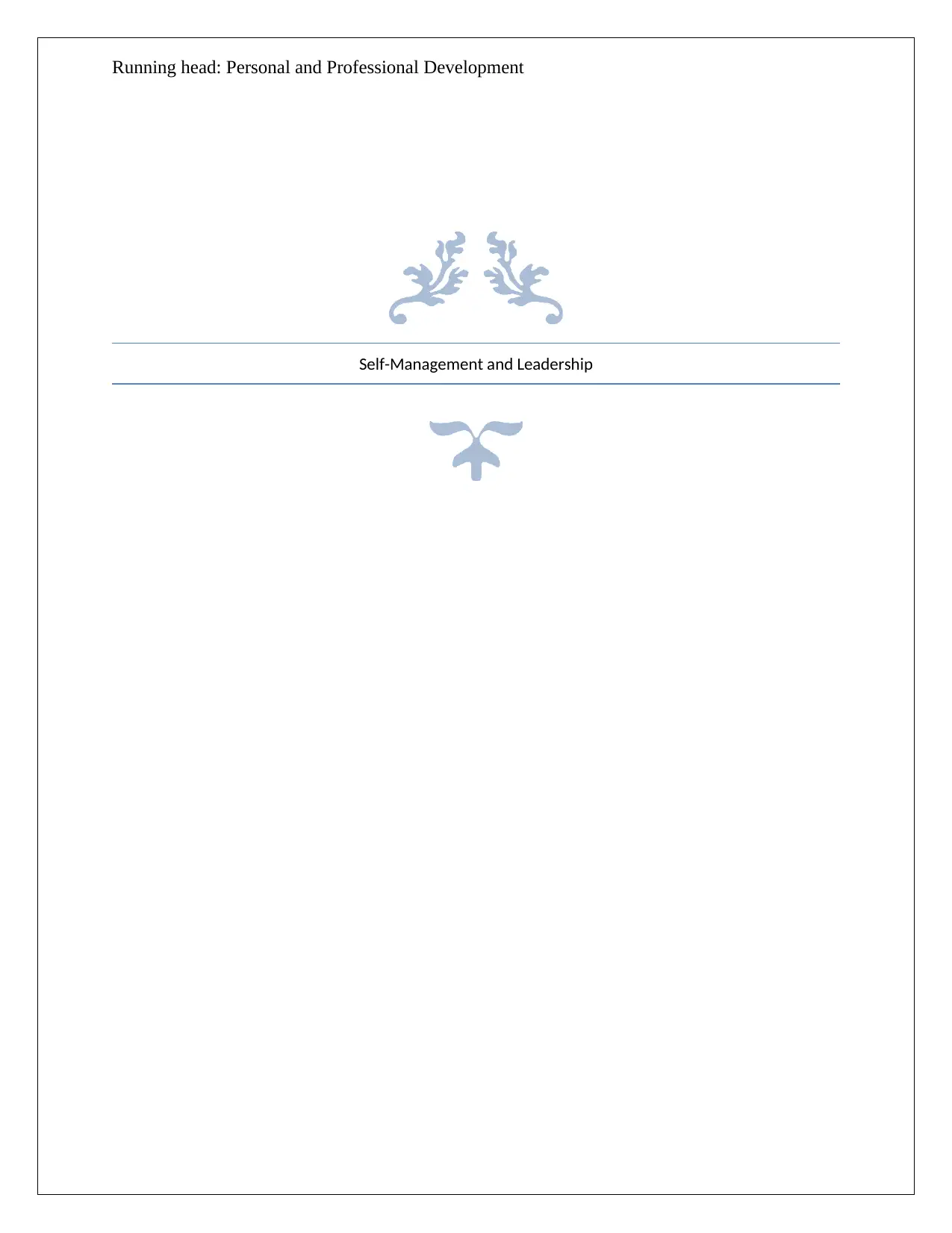
Running head: Personal and Professional Development
Self-Management and Leadership
Self-Management and Leadership
Paraphrase This Document
Need a fresh take? Get an instant paraphrase of this document with our AI Paraphraser
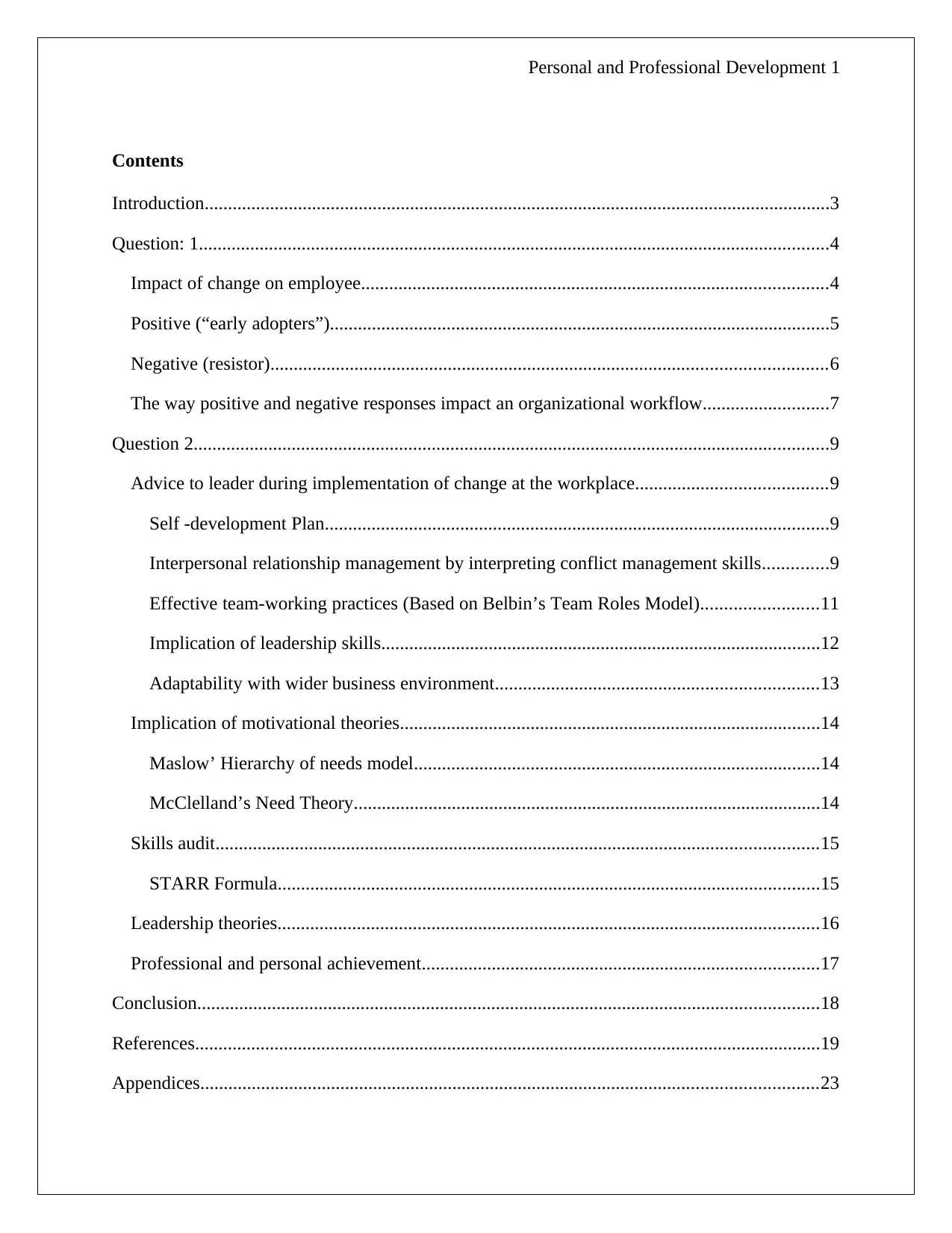
Personal and Professional Development 1
Contents
Introduction......................................................................................................................................3
Question: 1.......................................................................................................................................4
Impact of change on employee....................................................................................................4
Positive (“early adopters”)...........................................................................................................5
Negative (resistor).......................................................................................................................6
The way positive and negative responses impact an organizational workflow...........................7
Question 2........................................................................................................................................9
Advice to leader during implementation of change at the workplace.........................................9
Self -development Plan............................................................................................................9
Interpersonal relationship management by interpreting conflict management skills..............9
Effective team-working practices (Based on Belbin’s Team Roles Model).........................11
Implication of leadership skills..............................................................................................12
Adaptability with wider business environment.....................................................................13
Implication of motivational theories..........................................................................................14
Maslow’ Hierarchy of needs model.......................................................................................14
McClelland’s Need Theory....................................................................................................14
Skills audit.................................................................................................................................15
STARR Formula....................................................................................................................15
Leadership theories....................................................................................................................16
Professional and personal achievement.....................................................................................17
Conclusion.....................................................................................................................................18
References......................................................................................................................................19
Appendices....................................................................................................................................23
Contents
Introduction......................................................................................................................................3
Question: 1.......................................................................................................................................4
Impact of change on employee....................................................................................................4
Positive (“early adopters”)...........................................................................................................5
Negative (resistor).......................................................................................................................6
The way positive and negative responses impact an organizational workflow...........................7
Question 2........................................................................................................................................9
Advice to leader during implementation of change at the workplace.........................................9
Self -development Plan............................................................................................................9
Interpersonal relationship management by interpreting conflict management skills..............9
Effective team-working practices (Based on Belbin’s Team Roles Model).........................11
Implication of leadership skills..............................................................................................12
Adaptability with wider business environment.....................................................................13
Implication of motivational theories..........................................................................................14
Maslow’ Hierarchy of needs model.......................................................................................14
McClelland’s Need Theory....................................................................................................14
Skills audit.................................................................................................................................15
STARR Formula....................................................................................................................15
Leadership theories....................................................................................................................16
Professional and personal achievement.....................................................................................17
Conclusion.....................................................................................................................................18
References......................................................................................................................................19
Appendices....................................................................................................................................23
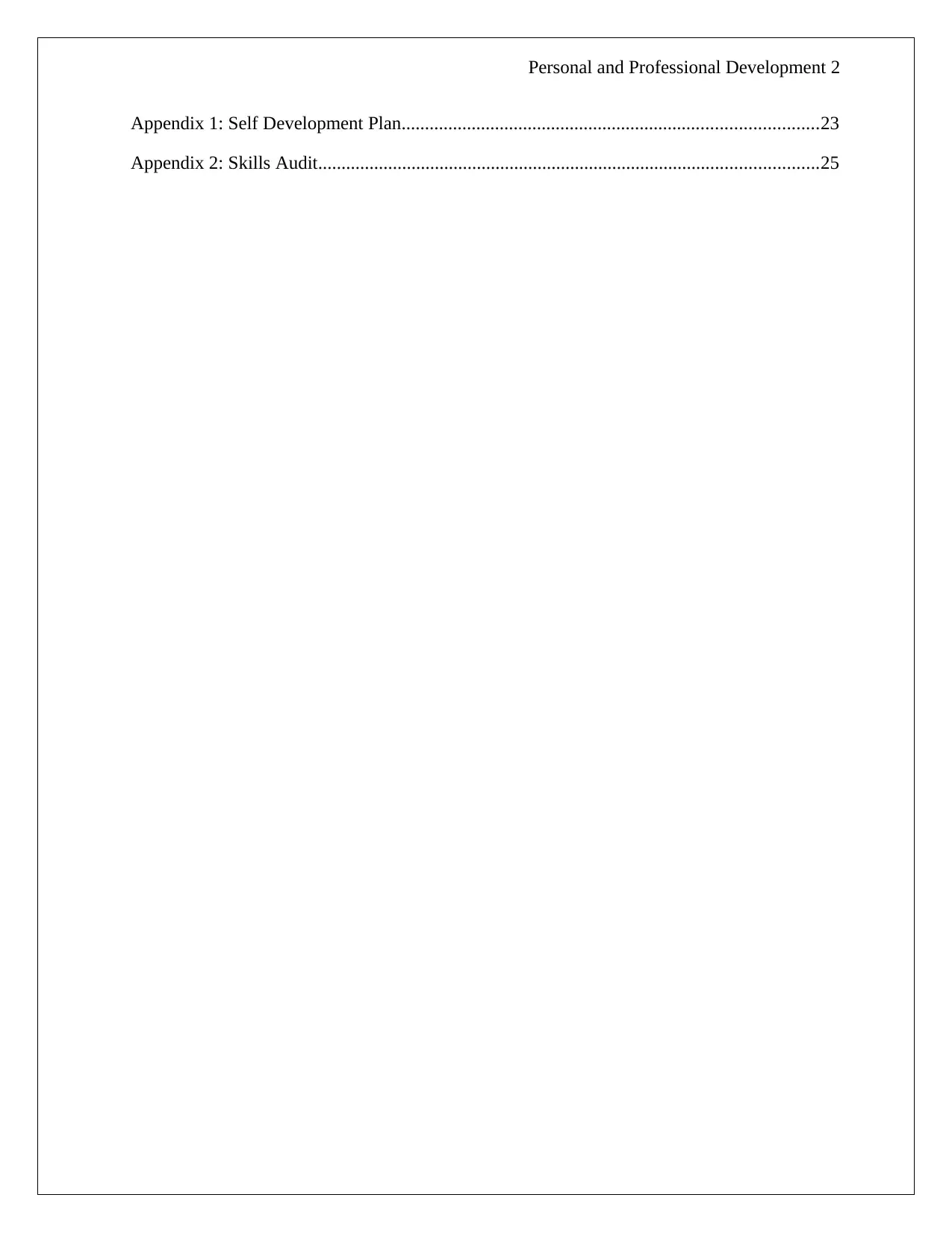
Personal and Professional Development 2
Appendix 1: Self Development Plan.........................................................................................23
Appendix 2: Skills Audit...........................................................................................................25
Appendix 1: Self Development Plan.........................................................................................23
Appendix 2: Skills Audit...........................................................................................................25
⊘ This is a preview!⊘
Do you want full access?
Subscribe today to unlock all pages.

Trusted by 1+ million students worldwide

Personal and Professional Development 3
Introduction
This study aims to understand the impact of reciprocation between the management and the
employees in terms of the organization growth that can implicate positive changes in its
workflow. Generally, business organizations have to deal with many stakeholders like
employees, leaders, consumers, suppliers and manufacturers. Among all major stakeholders’
employees are the basic pillars of any organization. Effective communication and co-operation
among the employees, leaders and the management is important for achieving challenging
professional as well as organizational goals. Moreover, to get organizational success in this
competitive, technologically advanced and modern world, flexible self-management, adaptability
and leadership skills is of profound importance. In this assignment I have noted down my self-
development plan and framework of my journey toward personal and professional success. I
believe to become an effective team-leader I need to identify my strengths-weaknesses and
sharpen my adaptability and communication skills. Elevation of leadership skills helps an
individual to sustain in the unprecedented era of 21st century. In this assignment I have
mentioned my major understandings and knowledge based on leadership self-assessment
activity, STARR Formula, leadership theories etc. that I gained from the scholarly readings and
articles (Hemerling, 2019).
Introduction
This study aims to understand the impact of reciprocation between the management and the
employees in terms of the organization growth that can implicate positive changes in its
workflow. Generally, business organizations have to deal with many stakeholders like
employees, leaders, consumers, suppliers and manufacturers. Among all major stakeholders’
employees are the basic pillars of any organization. Effective communication and co-operation
among the employees, leaders and the management is important for achieving challenging
professional as well as organizational goals. Moreover, to get organizational success in this
competitive, technologically advanced and modern world, flexible self-management, adaptability
and leadership skills is of profound importance. In this assignment I have noted down my self-
development plan and framework of my journey toward personal and professional success. I
believe to become an effective team-leader I need to identify my strengths-weaknesses and
sharpen my adaptability and communication skills. Elevation of leadership skills helps an
individual to sustain in the unprecedented era of 21st century. In this assignment I have
mentioned my major understandings and knowledge based on leadership self-assessment
activity, STARR Formula, leadership theories etc. that I gained from the scholarly readings and
articles (Hemerling, 2019).
Paraphrase This Document
Need a fresh take? Get an instant paraphrase of this document with our AI Paraphraser

Personal and Professional Development 4
Question: 1
Impact of change on employee
Employees and workers of an organization are responsible for implicating the business strategies
and critical decisions that are generated by the top-level management (Abiodun, 2014). The
overall ambience of an organization is critically dependent upon the roles and responsibilities
that are played by its employees. Leadership skills and progressive vision help a manager to
transform himself into a leader. Those ethical, managerial-leadership skills and motivating
approaches that have encouraged me to implement strategic changes into the organizational
behavior are noted down in this self-reflective report. I have written down my key observations
and learning outcomes that I gained throughout my professional career.
As mentioned by Sharif & Scandura, (2014) being a critical part of an organization, the kind of
moral values, ethical practices and business strategies the organization implement its work
culture severely impact the employees. Based on the personal nature, upbringing, professional
ambience, career goals and moral beliefs demands, needs and motivation vary from one to
another(Petronio, 2017).
Question: 1
Impact of change on employee
Employees and workers of an organization are responsible for implicating the business strategies
and critical decisions that are generated by the top-level management (Abiodun, 2014). The
overall ambience of an organization is critically dependent upon the roles and responsibilities
that are played by its employees. Leadership skills and progressive vision help a manager to
transform himself into a leader. Those ethical, managerial-leadership skills and motivating
approaches that have encouraged me to implement strategic changes into the organizational
behavior are noted down in this self-reflective report. I have written down my key observations
and learning outcomes that I gained throughout my professional career.
As mentioned by Sharif & Scandura, (2014) being a critical part of an organization, the kind of
moral values, ethical practices and business strategies the organization implement its work
culture severely impact the employees. Based on the personal nature, upbringing, professional
ambience, career goals and moral beliefs demands, needs and motivation vary from one to
another(Petronio, 2017).

Personal and Professional Development 5
Positive (“early adopters”)
These kinds of individuals are familiar with technological advancements that are going around
and are enthusiastic enough to implicate their knowledge in the workplace. For instance, young
software developers, content writers and creative bloggers use new technology, innovations,
writing skills and knowledge in order to figure out best use cases in the workflow. These early
adopters are capable of transforming their ideas into actions by their visionary leadership skills.
To become a leader, an individual must be creative enough regarding strategic planning, business
ideas and transcending of his own ideas into other employees or followers. Creative and
enthusiastic persons can be part of the leading personalities. But zealous, demotivated and
dissatisfied with one’s own job role can make that individual transform into a resistor. That
person resists any kind of positive changes, uncertainty or risks and loves to follow traditional
work procedure. This can be better understood by Hofstede’s dimensions of culture theory and
application. Uncertainty avoidance index deals in risk taking plus tolerance for uncertainty and
tendency of a society whereas restraint versus indulgence helps an organization togratify its
desires, needs and regulate social activities (Takey & de Carvalho, 2015).
.
Positive (“early adopters”)
These kinds of individuals are familiar with technological advancements that are going around
and are enthusiastic enough to implicate their knowledge in the workplace. For instance, young
software developers, content writers and creative bloggers use new technology, innovations,
writing skills and knowledge in order to figure out best use cases in the workflow. These early
adopters are capable of transforming their ideas into actions by their visionary leadership skills.
To become a leader, an individual must be creative enough regarding strategic planning, business
ideas and transcending of his own ideas into other employees or followers. Creative and
enthusiastic persons can be part of the leading personalities. But zealous, demotivated and
dissatisfied with one’s own job role can make that individual transform into a resistor. That
person resists any kind of positive changes, uncertainty or risks and loves to follow traditional
work procedure. This can be better understood by Hofstede’s dimensions of culture theory and
application. Uncertainty avoidance index deals in risk taking plus tolerance for uncertainty and
tendency of a society whereas restraint versus indulgence helps an organization togratify its
desires, needs and regulate social activities (Takey & de Carvalho, 2015).
.
⊘ This is a preview!⊘
Do you want full access?
Subscribe today to unlock all pages.

Trusted by 1+ million students worldwide
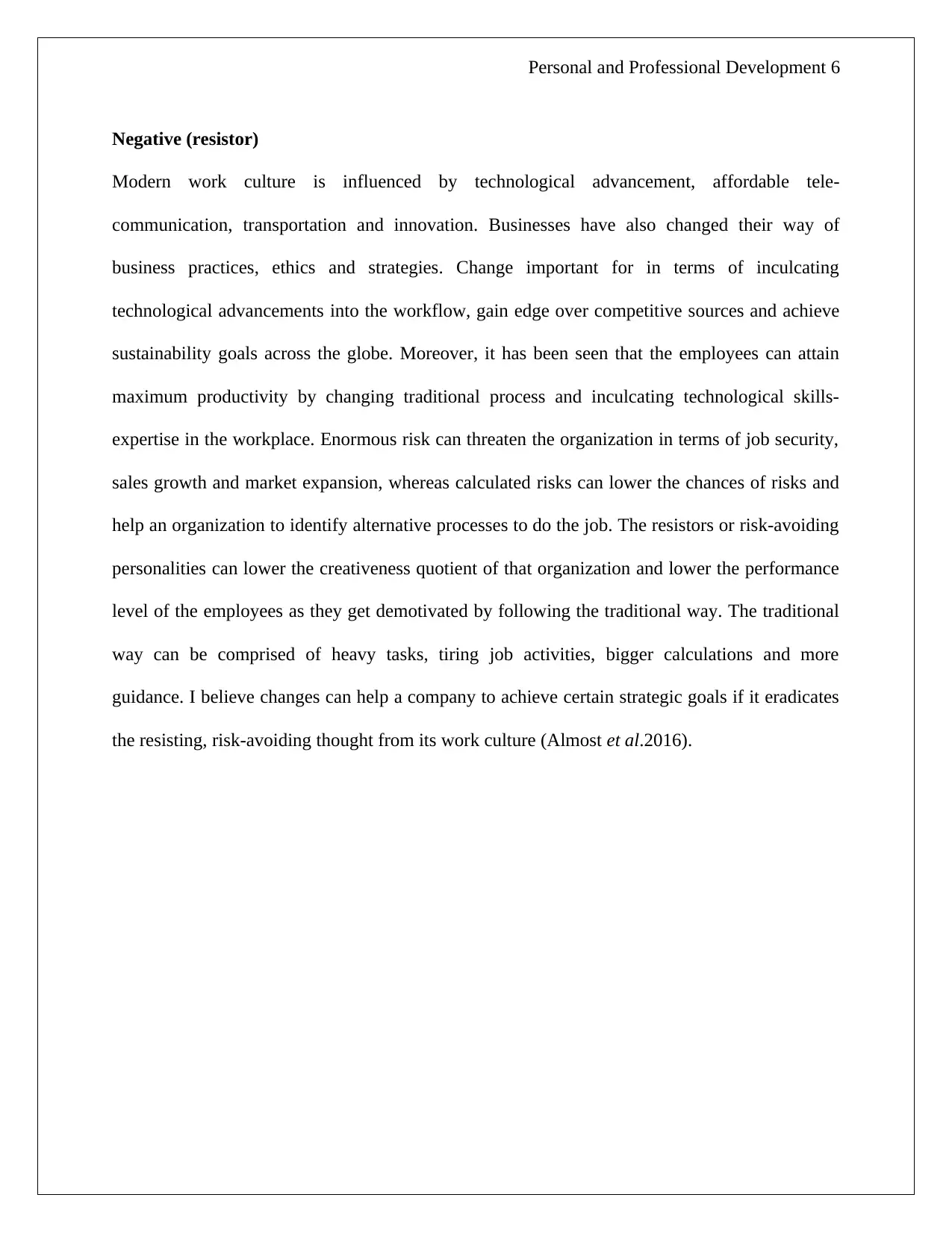
Personal and Professional Development 6
Negative (resistor)
Modern work culture is influenced by technological advancement, affordable tele-
communication, transportation and innovation. Businesses have also changed their way of
business practices, ethics and strategies. Change important for in terms of inculcating
technological advancements into the workflow, gain edge over competitive sources and achieve
sustainability goals across the globe. Moreover, it has been seen that the employees can attain
maximum productivity by changing traditional process and inculcating technological skills-
expertise in the workplace. Enormous risk can threaten the organization in terms of job security,
sales growth and market expansion, whereas calculated risks can lower the chances of risks and
help an organization to identify alternative processes to do the job. The resistors or risk-avoiding
personalities can lower the creativeness quotient of that organization and lower the performance
level of the employees as they get demotivated by following the traditional way. The traditional
way can be comprised of heavy tasks, tiring job activities, bigger calculations and more
guidance. I believe changes can help a company to achieve certain strategic goals if it eradicates
the resisting, risk-avoiding thought from its work culture (Almost et al.2016).
Negative (resistor)
Modern work culture is influenced by technological advancement, affordable tele-
communication, transportation and innovation. Businesses have also changed their way of
business practices, ethics and strategies. Change important for in terms of inculcating
technological advancements into the workflow, gain edge over competitive sources and achieve
sustainability goals across the globe. Moreover, it has been seen that the employees can attain
maximum productivity by changing traditional process and inculcating technological skills-
expertise in the workplace. Enormous risk can threaten the organization in terms of job security,
sales growth and market expansion, whereas calculated risks can lower the chances of risks and
help an organization to identify alternative processes to do the job. The resistors or risk-avoiding
personalities can lower the creativeness quotient of that organization and lower the performance
level of the employees as they get demotivated by following the traditional way. The traditional
way can be comprised of heavy tasks, tiring job activities, bigger calculations and more
guidance. I believe changes can help a company to achieve certain strategic goals if it eradicates
the resisting, risk-avoiding thought from its work culture (Almost et al.2016).
Paraphrase This Document
Need a fresh take? Get an instant paraphrase of this document with our AI Paraphraser

Personal and Professional Development 7
The way positive and negative responses impact an organizational workflow
Positive and negative responses that are generated by early adopters and hostile resistors can
impact an organization in an active as well as passive manner (Kimbell, 2011). Collaboration
between these two variances is responsible for creating the change initiatives in the organization.
The appropriate business dealings, strategic decisions are all part this process for dealing with in
domestic and international level.
Figure: Table on positive and negative responses
Source: (Meier et al. 2013)
Negative attitudes like risk-avoidance, less communication, arrogance, ego, authoritarian
mentality, harsh behavior with collogues and workers, less responsive to customer and anger can
exploit an individual’s image in front his followers. Unprecedented risks must be avoided
whereas calculated risks on strategic changes, new sales-marketing schemes, creativity and
innovative ideas can elevate the overall growth of an organization.
The way positive and negative responses impact an organizational workflow
Positive and negative responses that are generated by early adopters and hostile resistors can
impact an organization in an active as well as passive manner (Kimbell, 2011). Collaboration
between these two variances is responsible for creating the change initiatives in the organization.
The appropriate business dealings, strategic decisions are all part this process for dealing with in
domestic and international level.
Figure: Table on positive and negative responses
Source: (Meier et al. 2013)
Negative attitudes like risk-avoidance, less communication, arrogance, ego, authoritarian
mentality, harsh behavior with collogues and workers, less responsive to customer and anger can
exploit an individual’s image in front his followers. Unprecedented risks must be avoided
whereas calculated risks on strategic changes, new sales-marketing schemes, creativity and
innovative ideas can elevate the overall growth of an organization.

Personal and Professional Development 8
Moreover, I have learnt that varied emotional as well as intellectual quotient are important for
differentiating between early adopters and hostile resistors who can actively or passively reflect
changes in the workplace (Paletz, Miron-Spektor & Lin, 2014).
Moreover, I have learnt that varied emotional as well as intellectual quotient are important for
differentiating between early adopters and hostile resistors who can actively or passively reflect
changes in the workplace (Paletz, Miron-Spektor & Lin, 2014).
⊘ This is a preview!⊘
Do you want full access?
Subscribe today to unlock all pages.

Trusted by 1+ million students worldwide

Personal and Professional Development 9
Question 2
Advice to leader during implementation of change at the workplace
I want to work with Research Integrity Advisor (RIA) which is an Australian public research
university that caters quality knowledge on business administration, engineering, IT, humanities,
law, social science, medicine and health. From an employer’s perspective, I have seen that
organizations are going through continuous changes in terms of business strategies,
transformational leadership style, technological advancements, innovation and creativeness
(Hopkins & Yonker, 2015).
Self -development Plan
I have to overlook and maintain strong relationship between the teaching staffs and students
(Razzouk & Shute, 2012). Being a part of external stakeholder, I will deal with research scholars,
professors, fellow researchers and students, investigate any kind of research complaints and
resolve the issues. I will responsible for looking into the conflict management, observe stress
performance and practice team management skills for strengthening the organization structure.
For improving my self-management practices, I started detailed diary keeping and created a to-
do list (Folger, Poole & Stutman, 2015).
Interpersonal relationship management by interpreting conflict management skills
After analysing those reports and audits I wish to reflect uponmy conflict management and
communication skills. Being a student, I have seen several conflicts regarding misconduct by
professors, inattentiveness of the students was hampering the overall growth of the individuals
(Wery & Thomson, 2013). As per the study, conflict management skills can be further bifurcated
Question 2
Advice to leader during implementation of change at the workplace
I want to work with Research Integrity Advisor (RIA) which is an Australian public research
university that caters quality knowledge on business administration, engineering, IT, humanities,
law, social science, medicine and health. From an employer’s perspective, I have seen that
organizations are going through continuous changes in terms of business strategies,
transformational leadership style, technological advancements, innovation and creativeness
(Hopkins & Yonker, 2015).
Self -development Plan
I have to overlook and maintain strong relationship between the teaching staffs and students
(Razzouk & Shute, 2012). Being a part of external stakeholder, I will deal with research scholars,
professors, fellow researchers and students, investigate any kind of research complaints and
resolve the issues. I will responsible for looking into the conflict management, observe stress
performance and practice team management skills for strengthening the organization structure.
For improving my self-management practices, I started detailed diary keeping and created a to-
do list (Folger, Poole & Stutman, 2015).
Interpersonal relationship management by interpreting conflict management skills
After analysing those reports and audits I wish to reflect uponmy conflict management and
communication skills. Being a student, I have seen several conflicts regarding misconduct by
professors, inattentiveness of the students was hampering the overall growth of the individuals
(Wery & Thomson, 2013). As per the study, conflict management skills can be further bifurcated
Paraphrase This Document
Need a fresh take? Get an instant paraphrase of this document with our AI Paraphraser

Personal and Professional Development 10
into constructive and destructive conflicts (Chun & Choi, 2014). Understanding of conflict helps
to divide these into several levels like-
• Level 1 – No conflict
• Level 2 – Latent conflict
• Level 3 –Issues to resolve
• Level 4 – Dispute
• Level 5 – Help
• Level 6 – Fight/Flight
• Level 7 – Intractable
For confronting conflict creating issues, I asked myself questions on how I should confront the
conflict (Gucciardi et al. 2013).
Figure: Goleman's Emotional Intelligence Model
into constructive and destructive conflicts (Chun & Choi, 2014). Understanding of conflict helps
to divide these into several levels like-
• Level 1 – No conflict
• Level 2 – Latent conflict
• Level 3 –Issues to resolve
• Level 4 – Dispute
• Level 5 – Help
• Level 6 – Fight/Flight
• Level 7 – Intractable
For confronting conflict creating issues, I asked myself questions on how I should confront the
conflict (Gucciardi et al. 2013).
Figure: Goleman's Emotional Intelligence Model
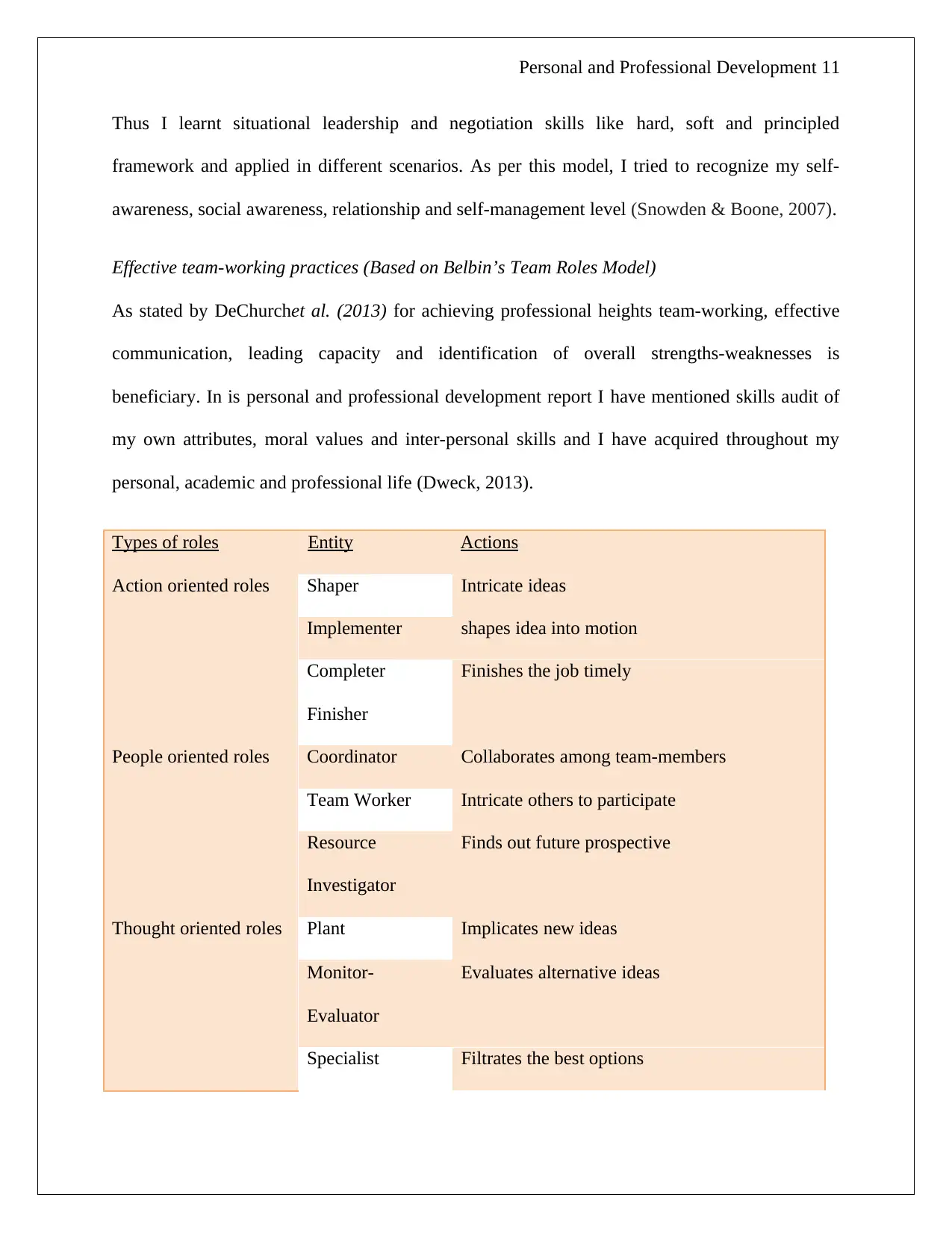
Personal and Professional Development 11
Thus I learnt situational leadership and negotiation skills like hard, soft and principled
framework and applied in different scenarios. As per this model, I tried to recognize my self-
awareness, social awareness, relationship and self-management level (Snowden & Boone, 2007).
Effective team-working practices (Based on Belbin’s Team Roles Model)
As stated by DeChurchet al. (2013) for achieving professional heights team-working, effective
communication, leading capacity and identification of overall strengths-weaknesses is
beneficiary. In is personal and professional development report I have mentioned skills audit of
my own attributes, moral values and inter-personal skills and I have acquired throughout my
personal, academic and professional life (Dweck, 2013).
Types of roles Entity Actions
Action oriented roles Shaper Intricate ideas
Implementer shapes idea into motion
Completer
Finisher
Finishes the job timely
People oriented roles Coordinator Collaborates among team-members
Team Worker Intricate others to participate
Resource
Investigator
Finds out future prospective
Thought oriented roles Plant Implicates new ideas
Monitor-
Evaluator
Evaluates alternative ideas
Specialist Filtrates the best options
Thus I learnt situational leadership and negotiation skills like hard, soft and principled
framework and applied in different scenarios. As per this model, I tried to recognize my self-
awareness, social awareness, relationship and self-management level (Snowden & Boone, 2007).
Effective team-working practices (Based on Belbin’s Team Roles Model)
As stated by DeChurchet al. (2013) for achieving professional heights team-working, effective
communication, leading capacity and identification of overall strengths-weaknesses is
beneficiary. In is personal and professional development report I have mentioned skills audit of
my own attributes, moral values and inter-personal skills and I have acquired throughout my
personal, academic and professional life (Dweck, 2013).
Types of roles Entity Actions
Action oriented roles Shaper Intricate ideas
Implementer shapes idea into motion
Completer
Finisher
Finishes the job timely
People oriented roles Coordinator Collaborates among team-members
Team Worker Intricate others to participate
Resource
Investigator
Finds out future prospective
Thought oriented roles Plant Implicates new ideas
Monitor-
Evaluator
Evaluates alternative ideas
Specialist Filtrates the best options
⊘ This is a preview!⊘
Do you want full access?
Subscribe today to unlock all pages.

Trusted by 1+ million students worldwide
1 out of 26
Related Documents
Your All-in-One AI-Powered Toolkit for Academic Success.
+13062052269
info@desklib.com
Available 24*7 on WhatsApp / Email
![[object Object]](/_next/static/media/star-bottom.7253800d.svg)
Unlock your academic potential
Copyright © 2020–2025 A2Z Services. All Rights Reserved. Developed and managed by ZUCOL.



